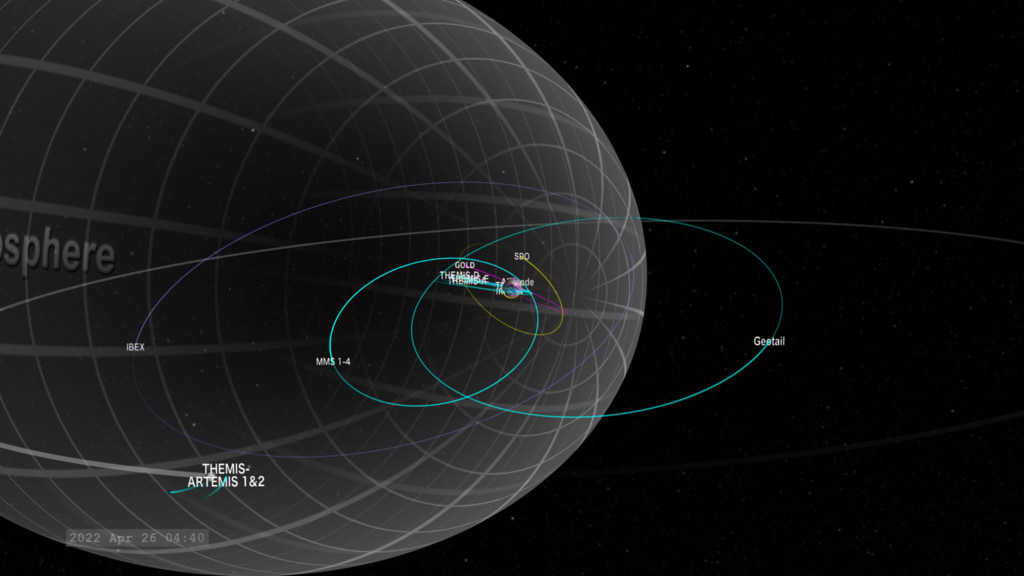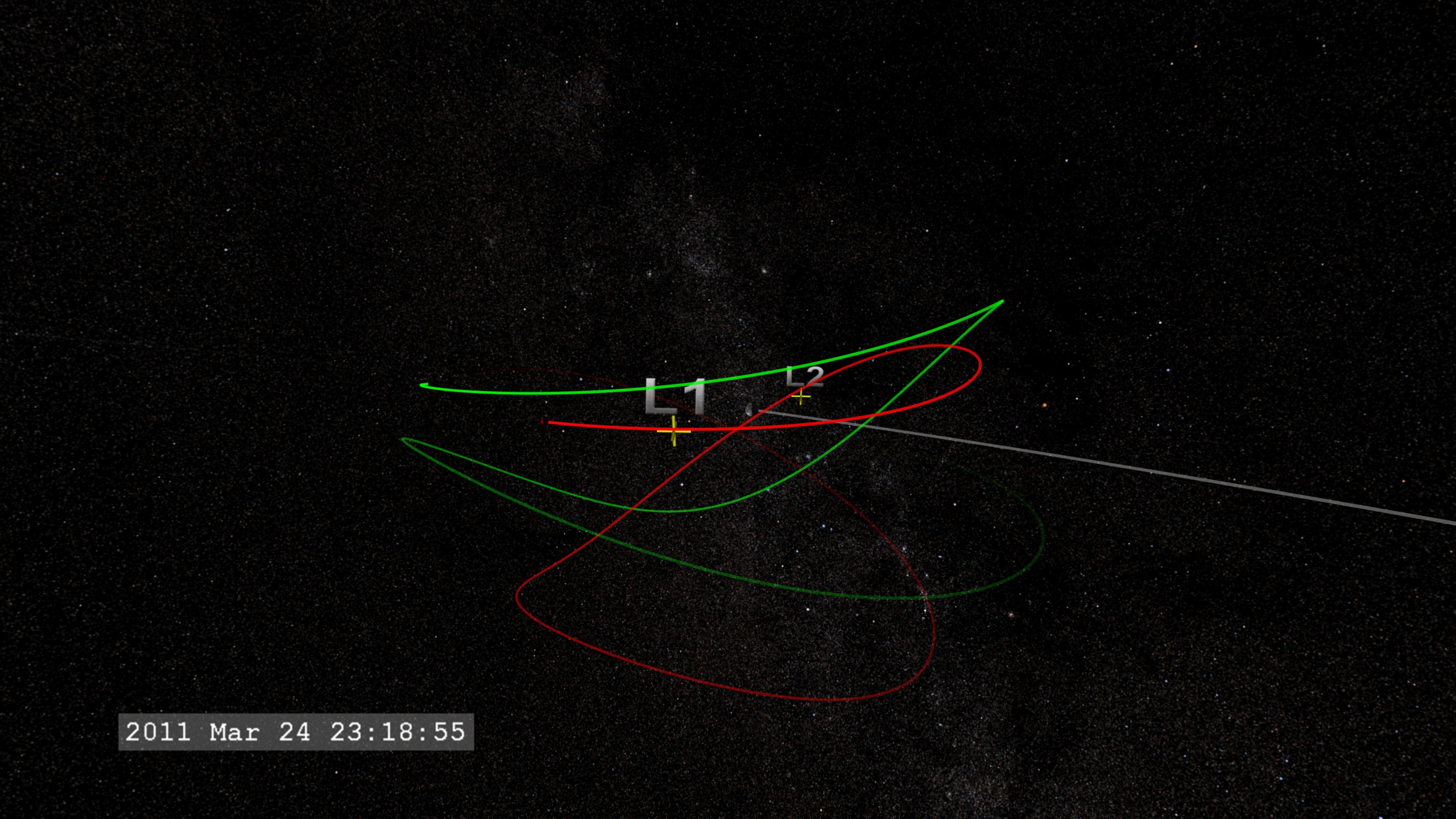Heliophysics Fleet - Past - Present - Future
Overview
Orbits and trajectories of many missions observing the Sun and the near-Earth environment.
Present
- Visualization
- Visualization
- Visualization
- Visualization
- Visualization
- Visualization
- Visualization
- Visualization
- Visualization
- Visualization
- Visualization
Narrated Videos
Sentinels of the Heliosphere
Go to this pageHeliophysics is a term to describe the study of the Sun, its atmosphere or the heliosphere, and the planets within it as a system. As a result, it encompasses the study of planetary atmospheres and their magnetic environment, or magnetospheres. These environments are important in the study of space weather.As a society dependent on technology, both in everyday life, and as part of our economic growth, space weather becomes increasingly important. Changes in space weather, either by solar events or geomagnetic events, can disrupt and even damage power grids and satellite communications. Space weather events can also generate x-rays and gamma-rays, as well as particle radiations, that can jeopardize the lives of astronauts living and working in space.This visualization tours the regions of near-Earth orbit; the Earth's magnetosphere, sometimes called geospace; the region between the Earth and the Sun; and finally out beyond Pluto, where Voyager 1 and 2 are exploring the boundary between the Sun and the rest of our Milky Way galaxy. Along the way, we see these regions patrolled by a fleet of satellites that make up NASA's Heliophysics Observatory Telescopes. Many of these spacecraft do not take images in the conventional sense but record fields, particle energies and fluxes in situ. Many of these missions are operated in conjunction with international partners, such as the European Space Agency (ESA) and the Japanese Space Agency (JAXA).The Earth and distances are to scale. Larger objects are used to represent the satellites and other planets for clarity.Here are the spacecraft featured in this movie:Near-Earth Fleet:Hinode: Observes the Sun in multiple wavelengths up to x-rays. SVS pageRHESSI : Observes the Sun in x-rays and gamma-rays. SVS pageTRACE: Observes the Sun in visible and ultraviolet wavelengths. SVS pageTIMED: Studies the upper layers (40-110 miles up) of the Earth's atmosphere.FAST: Measures particles and fields in regions where aurora form.CINDI: Measures interactions of neutral and charged particles in the ionosphere. AIM: Images and measures noctilucent clouds. SVS pageGeospace Fleet:Geotail: Conducts measurements of electrons and ions in the Earth's magnetotail. Cluster: This is a group of four satellites which fly in formation to measure how particles and fields in the magnetosphere vary in space and time. SVS pageTHEMIS: This is a fleet of five satellites to study how magnetospheric instabilities produce substorms. SVS pageL1 Fleet: The L1 point is a Lagrange Point, a point between the Earth and the Sun where the gravitational pull is approximately equal. Spacecraft can orbit this location for continuous coverage of the Sun.SOHO: Studies the Sun with cameras and a multitude of other instruments. SVS pageACE: Measures the composition and characteristics of the solar wind. Wind: Measures particle flows and fields in the solar wind. Heliospheric FleetSTEREO-A and B: These two satellites observe the Sun, with imagers and particle detectors, off the Earth-Sun line, providing a 3-D view of solar activity. SVS pageHeliopause FleetVoyager 1 and 2: These spacecraft conducted the original 'Planetary Grand Tour' of the solar system in the 1970s and 1980s. They have now travelled further than any human-built spacecraft and are still returning measurements of the interplanetary medium. SVS pageThis enhanced, narrated visualization was shown at the SIGGRAPH 2009 Computer Animation Festival in New Orleans, LA in August 2009; an eariler version created for AGU was called NASA's Heliophysics Observatories Study the Sun and Geospace. ||
Orbital Gymnastics
Cool ways to move spacecraft around using gravity and a little bit of fuel...
ARTEMIS at Lagrange
Go to this pageThis visualization is built from the components of ARTEMIS Mission with emphasis on the maneuvers of the two ARTEMIS spacecraft (red=ARTEMIS-1, green=ARTEMIS-2) around the lunar Lagrange Points L1 and L2.As with the ARTEMIS Mission visual, we show the Earth, the Earth's magnetosphere, the Moon and Sun, with the direction of the Sun from the Earth indicated by the yellow arrow.In this version, the satellite trails are are constructed in a lunar-centric inertial coordinate system so the trails reveal the motion of the satellites relative to the Lagrange points in INERTIAL space (fixed with the distant stars). To see another example of how coordinate systems dramatically affect the construction of trails, see LRO in Earth Centered and Moon Centered Coordinates.In this movie, the camera starts above the Moon's orbital plane and then slowly moves towards the Moon's orbital plane to get a better sense of the motion in 3-D space. For a different perspective, see ARTEMIS at Lagrange: The View from Above. ||
ARTEMIS at Lagrange: The View from Above
Go to this pageThis visualization is built from the components of ARTEMIS Mission with emphasis on the maneuvers of the two ARTEMIS spacecraft (red=ARTEMIS-1, green=ARTEMIS-2) around the lunar Lagrange Points L1 and L2.As with the ARTEMIS Mission visual, we show the Earth, the Earth's magnetosphere, the Moon and Sun, with the direction of the Sun from the Earth indicated by the yellow arrow.In this version, the satellite trails are are constructed in a lunar-centric inertial coordinate system so the trails reveal the motion of the satellites relative to the Lagrange points in INERTIAL space (fixed with the distant stars). To see another example of how coordinate systems dramatically affect the construction of trails, see LRO in Earth Centered and Moon Centered Coordinates.In this movie, the camera stays above the Moon's orbital plane for a better view of the motion in the orbital plane. For a change in perspective, see ARTEMIS at Lagrange. ||
ARTEMIS Mission
Go to this pageAn extension to the THEMIS mission is to send two of the THEMIS satellites into lunar orbit to study the magnetospheric environment near the Moon. The new mission is named ARTEMIS (Acceleration, Reconnection Turbulence, and Electrodynamics of Moon's Interaction with the Sun).The outermost two THEMIS spacecraft (Probes B and C) are on route to the Moon, where they will become the ARTEMIS mission's Probes 1 and 2 (red and green, respectively) , tasked with studying not only the tenuous cavity carved out by the Moon in the supersonic solar wind, but also reconnection, particle energization and turbulence in both the solar wind and the Earth's distant magnetotail at lunar distance. ARTEMIS stands for Acceleration, Reconnection, Turbulence, and Electrodynamics of the Moon's Interaction with the Sun.Thanks to careful planning, sufficient fuel remained on both spacecraft at the successful completion of their primary mission to raise their apogees to lunar distance, where they could receive the multiple gravitational assists needed to fling the spacecraft first beyond the Moon and then assist them in entering in orbits that parallel that of the Moon at the L1 and L2 Lagrange points. Maneuvers in April 2011 enable the spacecraft to enter into prograde and retrograde lunar orbits (the 'braided' motion).The direction of the Sun is indicated by the yellow arrow. ||














